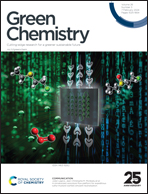CO2 sequestration in ultramafic ores: impacts on the efficiency of nickel beneficiation†
Abstract
We present a carbonation-assisted flotation method for nickel (Ni) separation from low-grade ultramafic ores. The high process economics of conventional flotation of low-grade ultramafic ores makes Ni unrecoverable on an industrial scale. Based on the fundamentals of CO2 sequestration in minerals, we carbonated a low-grade serpentine (lizardite) ore specimen under extreme conditions (185 °C, 15 MPa, and 24 h) and attained a conversion efficiency of serpentine to magnesite of 22% and 16% in the presence and absence of inorganic salts, respectively. Rhombohedral structures on carbonated particles detected using scanning electron microscopy suggested the formation of magnesite. We also found that Ni–Fe existed as sulfides, as confirmed by elemental mapping micrographs, and did not leach out as Ni2+ and Fe2+, as confirmed through carbonation supernatant analysis. Here, we introduced Denver cell froth flotation experiments after carbonation, which showed that the carbonated ore in the presence of inorganic salts had 29% higher Ni recovery and 0.15 wt% higher nickel grade than the uncarbonated ore. This study is the first to successfully show that the carbonation of serpentine containing nickel-bearing pentlandite leads to magnesite formation, does not lead to the dissolution of nickel sulphide, and enhances the nickel separation efficiency during froth flotation. This study paves the path forward for the integration of mineral carbonation in the processing of low-grade ultramafic nickel ores.



 Please wait while we load your content...
Please wait while we load your content...